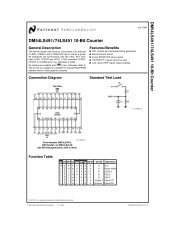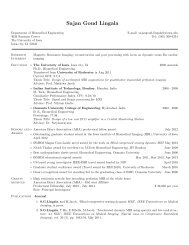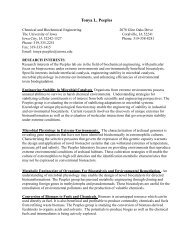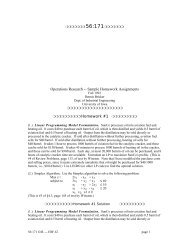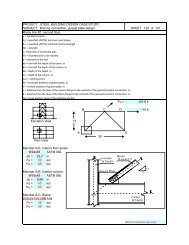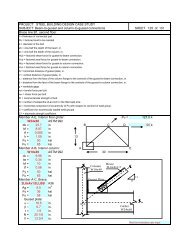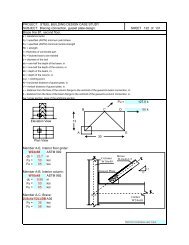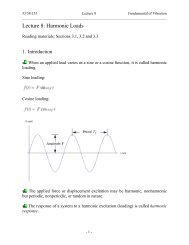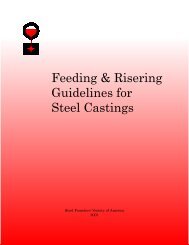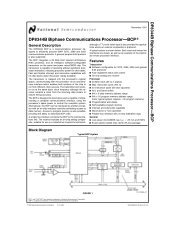Options Options Put Options Put Options Profit Diagram
Options Options Put Options Put Options Profit Diagram
Options Options Put Options Put Options Profit Diagram
Create successful ePaper yourself
Turn your PDF publications into a flip-book with our unique Google optimized e-Paper software.
<strong>Options</strong><br />
Peter O’Grady<br />
<strong>Put</strong> <strong>Options</strong><br />
A put option is a contract that gives the<br />
owner the right, but not the obligation, to<br />
sell an underlying asset, at a fixed price<br />
($K), on (or on or before) a specific day.<br />
The put writer is obligated to buy the<br />
underlying asset, and pay $K for it.<br />
Value of <strong>Put</strong> at Expiration (A.K.A.<br />
Payoff <strong>Diagram</strong>)<br />
P T<br />
0<br />
K<br />
S T<br />
1<br />
3<br />
5<br />
<strong>Options</strong><br />
<strong>Put</strong> <strong>Options</strong><br />
Call <strong>Options</strong><br />
Examples of derivatives<br />
<strong>Put</strong> <strong>Options</strong><br />
Define S as the price of the underlying<br />
asset, and K as the strike price.<br />
In, out of, and at the money for puts<br />
– In the money if S < K<br />
– Out of the money if S > K<br />
– At the money if S ~ K<br />
– Deep in (out of) the money if S > K)<br />
Intrinsic value of a put = max(0,K-S)<br />
<strong>Profit</strong> <strong>Diagram</strong> -- Long <strong>Put</strong><br />
(Buying a <strong>Put</strong>)<br />
<strong>Profit</strong><br />
0<br />
Just lower the payoff diagram<br />
by the put premium (price of<br />
put)to get the profit diagram<br />
K<br />
ST<br />
put premium<br />
2<br />
4<br />
6<br />
1
Example of a <strong>Put</strong> Option<br />
buy a put option to purchase 100 Exxon shares<br />
– strike price = $70<br />
– price of an option to buy one share = $7<br />
initial investment is 100 x $7 = $700<br />
The outcome<br />
– Exxon’s share price is $55 at the expiration<br />
– to exercise the option for a gain of<br />
($70-$55) x 100 = $1,500<br />
– the net gain = $1,500 - $700 = $800<br />
<strong>Profit</strong> <strong>Diagram</strong> – Short <strong>Put</strong><br />
(Selling a <strong>Put</strong>)<br />
<strong>Profit</strong><br />
0<br />
Call <strong>Options</strong><br />
K<br />
A call option is a contract that gives the<br />
owner the right, but not the obligation, to<br />
buy an underlying asset, at a fixed<br />
price, on (or on or before) a specific<br />
day.<br />
The fixed price is called the strike price,<br />
or the exercise price.<br />
ST<br />
7<br />
9<br />
11<br />
Example of a <strong>Put</strong> Option (cont.)<br />
<strong>Profit</strong> ($)<br />
3000<br />
2500<br />
2000<br />
1500<br />
1000<br />
500<br />
0<br />
-700<br />
-1000<br />
-1500<br />
40<br />
50 60 70 80<br />
Terminal stock price ($)<br />
Figure <strong>Profit</strong> from buying a <strong>Put</strong> Option on 100 Exxon share. Option<br />
price = $7; strike price = $70<br />
Insurance<br />
Insurance. If you own the underlying<br />
asset, buying a put provides<br />
protection against the possibility that<br />
the underlying asset price will fall<br />
below $K. Of course, insurance costs<br />
money (the put premium).<br />
Call <strong>Options</strong><br />
In, out of, and at the money: Define S<br />
as the price of the underlying asset, and<br />
K as the strike price. Then, for a call:<br />
– In the money if S > K<br />
– Out of the money if S < K<br />
– At the money if S ~ K<br />
– Deep in (out of) the money if S >> K<br />
(S
C T<br />
Value of Call at Expiration, (A.K.A.<br />
Payoff <strong>Diagram</strong>)<br />
0<br />
Example of a Call Option<br />
buy a call option to purchase 100 MSFT share<br />
K<br />
– strike price = $52<br />
– current share price = $50<br />
– price of an option to buy one share = $2<br />
initial investment is 100 x $2 = $200<br />
The outcome<br />
– MSFT’s share price is $55 at the expiration<br />
– to exercise the option for a gain of ($55-$52) x 100<br />
= $300<br />
– the net gain = $300 - $200 = $100<br />
Example of a Call Option<br />
buy a call option to purchase 100 IBM shares<br />
– strike price = $100<br />
– current share price = $98<br />
– price of an option to buy one share = $5<br />
initial investment is 100 x $5 = $500 (Worse case is<br />
that this will be lost)<br />
The outcome<br />
– IBM’s share price is $115 at the expiration<br />
– to exercise the option for a gain of<br />
($115-$100) x 100 = $1,500<br />
– the net gain = $1,500 - $500 = $1,000<br />
ST<br />
13<br />
15<br />
17<br />
<strong>Profit</strong> <strong>Diagram</strong> -- Long Call<br />
(Buying a Call Option)<br />
<strong>Profit</strong><br />
0<br />
Just lower the payoff diagram<br />
by the call premium (price of the option), to get the<br />
profit diagram<br />
call premium<br />
Example of a Call Option (cont.)<br />
<strong>Profit</strong> ($)<br />
1200<br />
1000<br />
800<br />
600<br />
400<br />
200<br />
0<br />
-200<br />
-400<br />
-600<br />
50<br />
K<br />
60 70 80 90<br />
ST<br />
Terminal stock price ($)<br />
Example of a Call Option (cont.)<br />
<strong>Profit</strong> ($)<br />
3000<br />
2500<br />
2000<br />
1500<br />
1000<br />
500<br />
0<br />
-500<br />
-1000<br />
-1500<br />
90<br />
100 110 120 130<br />
Terminal stock price ($)<br />
Figure <strong>Profit</strong> from buying a Call Option on 100 IBM share. Option<br />
price = $5; strike price = $100<br />
14<br />
16<br />
18<br />
3
<strong>Profit</strong> <strong>Diagram</strong> – Short Call<br />
(Selling a Call Option)<br />
<strong>Profit</strong><br />
0<br />
Example of a <strong>Put</strong> Option (cont.)<br />
700<br />
0<br />
-500<br />
-1000<br />
-1500<br />
-2000<br />
-2500<br />
-3000<br />
-3500<br />
-4000<br />
<strong>Profit</strong> ($)<br />
40<br />
K<br />
50 60 70 80<br />
Terminal stock price ($)<br />
Figure <strong>Profit</strong> from writing a <strong>Put</strong> Option on 100 Exxon share. Option<br />
price = $7; strike price = $70<br />
90<br />
100<br />
ST<br />
19<br />
21<br />
Example of a Call Option (cont.)<br />
<strong>Profit</strong> ($)<br />
1000<br />
500<br />
0<br />
-500<br />
-1000<br />
-1500<br />
-2000<br />
-2500<br />
-3000<br />
-3500<br />
90<br />
Terminal stock price ($)<br />
100 110 120 130<br />
Figure <strong>Profit</strong> from writing a Call Option on 100 IBM share. Option<br />
price = $5; strike price = $100<br />
Option Positions (cont.)<br />
<strong>Profit</strong><br />
<strong>Profit</strong><br />
X<br />
(a) long call<br />
X<br />
S T<br />
S T<br />
<strong>Profit</strong><br />
X<br />
ST (b) short call<br />
<strong>Profit</strong><br />
(c) long put (d) short put<br />
X<br />
S T<br />
20<br />
22<br />
4




